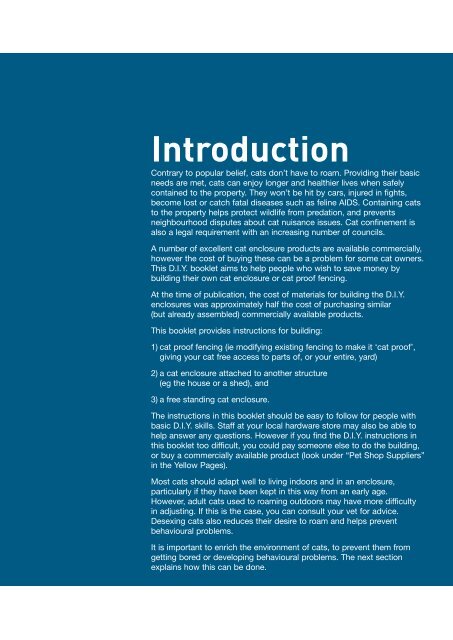How to build a cat enclosure - City of Tea Tree Gully
How to build a cat enclosure - City of Tea Tree Gully
How to build a cat enclosure - City of Tea Tree Gully
Create successful ePaper yourself
Turn your PDF publications into a flip-book with our unique Google optimized e-Paper software.
IntroductionContrary <strong>to</strong> popular belief, <strong>cat</strong>s don’t have <strong>to</strong> roam. Providing their basicneeds are met, <strong>cat</strong>s can enjoy longer and healthier lives when safelycontained <strong>to</strong> the property. They won’t be hit by cars, injured in fights,become lost or <strong>cat</strong>ch fatal diseases such as feline AIDS. Containing <strong>cat</strong>s<strong>to</strong> the property helps protect wildlife from predation, and preventsneighbourhood disputes about <strong>cat</strong> nuisance issues. Cat confinement isalso a legal requirement with an increasing number <strong>of</strong> councils.A number <strong>of</strong> excellent <strong>cat</strong> <strong>enclosure</strong> products are available commercially,however the cost <strong>of</strong> buying these can be a problem for some <strong>cat</strong> owners.This D.I.Y. booklet aims <strong>to</strong> help people who wish <strong>to</strong> save money by<strong>build</strong>ing their own <strong>cat</strong> <strong>enclosure</strong> or <strong>cat</strong> pro<strong>of</strong> fencing.At the time <strong>of</strong> publi<strong>cat</strong>ion, the cost <strong>of</strong> materials for <strong>build</strong>ing the D.I.Y.<strong>enclosure</strong>s was approximately half the cost <strong>of</strong> purchasing similar(but already assembled) commercially available products.This booklet provides instructions for <strong>build</strong>ing:1) <strong>cat</strong> pro<strong>of</strong> fencing (ie modifying existing fencing <strong>to</strong> make it ‘<strong>cat</strong> pro<strong>of</strong>’,giving your <strong>cat</strong> free access <strong>to</strong> parts <strong>of</strong>, or your entire, yard)2) a <strong>cat</strong> <strong>enclosure</strong> attached <strong>to</strong> another structure(eg the house or a shed), and3) a free standing <strong>cat</strong> <strong>enclosure</strong>.The instructions in this booklet should be easy <strong>to</strong> follow for people withbasic D.I.Y. skills. Staff at your local hardware s<strong>to</strong>re may also be able <strong>to</strong>help answer any questions. <strong>How</strong>ever if you find the D.I.Y. instructions inthis booklet <strong>to</strong>o difficult, you could pay someone else <strong>to</strong> do the <strong>build</strong>ing,or buy a commercially available product (look under “Pet Shop Suppliers”in the Yellow Pages).Most <strong>cat</strong>s should adapt well <strong>to</strong> living indoors and in an <strong>enclosure</strong>,particularly if they have been kept in this way from an early age.<strong>How</strong>ever, adult <strong>cat</strong>s used <strong>to</strong> roaming outdoors may have more difficultyin adjusting. If this is the case, you can consult your vet for advice.Desexing <strong>cat</strong>s also reduces their desire <strong>to</strong> roam and helps preventbehavioural problems.It is important <strong>to</strong> enrich the environment <strong>of</strong> <strong>cat</strong>s, <strong>to</strong> prevent them fromgetting bored or developing behavioural problems. The next sectionexplains how this can be done.

















